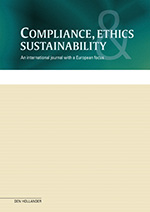Which digital innovations can enhance the combat of financial institutions to detect Financial Economic Crime?
S.J. van Eerten MSc EMoC & mr. K.E.J. van Heugten
Introduction The digitalization of banking not only opens up unprecedented opportunities for individuals and organizations to conduct their business, but also for the prevention and detection of Financial Economic Crime1 (FEC). Where Know Your Customer (KYC) traditionally is recognized as ‘slack’ in banking processes, digital innovations show how banks can reinvent themselves and become future-proof; both from a regulatory as well as a cost-efficiency perspective. For years now, financial crime has become a ‘stayawake’ issue for
Artikel kopen € 79,00 excl. BTW
In plaats van abonneren kunt u dit artikel ook afzonderlijk kopen.
corporate directors and board members around the world. The stakes to protect corporations and society from the impact of financial crime are high. The level at which criminals are targeting financial institutions has reached an all-time high, and the likelihood of this abating any time soon is low. The World Economic Forum Global Risk Report 2017 has placed a number of risks both directly and indirectly related to financial crime on its top 10 list of high likelihood and impact: large-scale terrorist attacks, weapons of mass destruction, massive incidents of data fraud/theft and illicit trade.2 The report goes on to say ‘slow growth, high debt and demographic change creates an environment that favours financial crises, pervasive corruption, short-termism and unequal benefits of growth’. Financial institutions need to look for opportunities to reduce compliance costs, enhance customer experiences and generate new business models while remaining compliant While it’s difficult to quantify the costs of financial crime for organizations, there is no doubt it has become a significant issue for financial institutions and one that is getting more challenging by the day. What is clear is that financial institutions cannot keep on top of all these dynamic threats by tackling today’s incidents with yesterday’s strategies. Financial institutions need to look for opportunities to reduce compliance costs, enhance customer experiences and generate new business models while remaining compliant. This article sets out how financial institutions can accomplish this with ‘Digital KYC’. First the current state and trends in fighting FEC are described. Next, key elements for Digital KYC are discussed, such as Robotics, Artificial Intelligence and Smart Identity.
U heeft op dit moment geen toegang tot de volledige inhoud van dit product. U kunt alleen de inleiding en hoofdstukindeling lezen.
Wanneer u volledige toegang wenst tot alle informatie kunt u zich abonneren of inloggen als abonnee.




